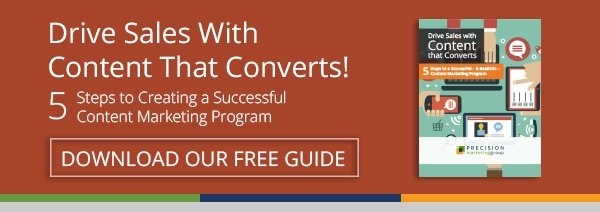“Help Sales close deals, and they will become your best friend.”
Nick Panayi, Digital Marketing VP from DXC Technology, has got it right. If Marketing is doing its job correctly, they’re helping your business grow. Not only are they delivering qualified leads and managing your company’s website and branding, they’re accelerating the sales pipeline and getting involved with your selling processes right from the start. They’re doing the very activities that make sales reps happy, and while Sales needs to pull its own weight and effectively leverage the tools Marketing creates for their strategy, Marketing’s role should also be sales-driven.
The two parties working together has never been more important. Take a look at these compelling statistics:
- Misalignment between sales and marketing technologies and processes costs B2B companies 10% of revenue or more per year.
- Companies with good sales and marketing alignment generate 208% more revenue.
- When sales and marketing teams work together harmoniously, companies typically see 36% higher customer retention and 38% higher close rates.
Sales and Marketing are like peanut butter and jelly. They are a powerful combination – or at least they should be! If they’re currently tasting more like cat food on burnt toast (that’s the most disgusting thing I could think of at the moment), then it’s time to put some effort into aligning your two teams.
And for the record, I have never tasted cat food.
Given that 75 percent of companies say closing more deals is their top sales priority, Marketing should be meeting with Sales regularly to ensure they’re doing everything they can to help out. After all, growing the business is a win for everybody, right? But meetings and closed-loop data sharing alone are not enough. If you really want your sales reps to be thankful for you come Turkey Day, implementing these 10 sales enablement best practices is sure to do the trick.
1. Produce content for every stage in the sales cycle.
The whole point of sales enablement content is to help your reps build credibility, educate prospects and overcome objections those prospects might have during the sales process. But not all business buyers are created equally, so to speak. Each stage in the sales cycle requires different types of content, and your various buyer personas all have specific needs, as well.
For example, perhaps your sales team has done some prospecting of their own and they’d like to reach out to a good-fit candidate for your services via LinkedIn. For those contacts floating around at the top of your funnel, a couple blog posts on helpful industry-related topics might serve as a good conversation starter. On-demand webinar recordings or eGuides may be more appropriate nurturing tools for contacts in the middle of the funnel, while case studies and more concrete offerings (like a snazzy pricing page) could appeal to those in the decision making process.
Talk to your sales team and find out what types of content would be most helpful, and add these projects onto your marketing to-do list. Moreover, ask for insights from Sales as to why some leads go dark even after they appeared to be promising at the beginning of the sales process. What might convince them to re-engage? Produce a piece that heats up a cold contact, and your sales reps will love you for it.
2. Provide updates on published content.
Whenever a new blog post goes out or a new white paper is completed, alert your sales team. Better yet, provide your reps with the content’s context and perhaps a little blurb they can use in sales conversations. They’ll appreciate having this information in the event they know someone in the pipeline who would particularly find the resource valuable.
Conducting a content asset inventory should already be part of your marketing and business growth strategy. It’s likely your company already has lots of content that can be repurposed into helpful sales documents. But it’s also a good idea to lasso all of your best blog posts, downloadable guides, technical docs, videos, etc. into one categorized “resource bank” that sales team members can access at all times.
3. Make communication easy.
Half the battle with marketing and sales alignment is consistently keeping communication flowing. Especially if you work in a virtual environment or in a workplace where your desks/offices aren’t so close together, a convenient means of sharing ideas and information is critical.
One platform we highly recommend using for this purpose is Slack. Ask around and you’ll find that many tech-savvy companies are using it for all kinds of things, but setting up a channel (or a couple different channels) for Marketing and Sales to use to efficiently exchange data and links to handy resources is going to make a big difference when it comes to interdepartmental cooperation. And, of course, occasional jokes, puppy photos and timely GIFs and emojis can’t hurt company morale either.
4. Hold joint brainstorming sessions.
Setting aside time on a monthly basis for both groups to review what’s working and what isn’t working—and to generate some fresh ideas—is only going to make your organization stronger. You could even invite a few team members from other sides of the business (Product, Operations, Customer Service, etc.) to weigh in on new sales enablement content ideas.
However, we all know some of the best, most creative ideas we have come to us outside of work… in the shower, at the gym, milling about the grocery store (or is that one just me?). And some people are simply more comfortable sharing their thoughts after a group meeting. To maximize the number of opportunities people have to jot down new ideas or content topics, set up a thread or message board (using an app like Trello) that provides a creative outlet for all team members.
5. Conduct SME interviews.
Your salespeople are in sales for a reason. They know your product or service inside and out, they’re great communicators, and they know how to translate their expertise into some stellar sound bites. They’re also on the front lines every day, so they’re constantly getting feedback from prospects and customers. Doesn’t that qualify them as excellent sources of blog post material? Yes, it does.
If they have the time and approval from leadership, why not have you sales reps write a post every now on then for your company blog? Or if they don’t have time to write, or maybe content writing just isn’t their talent, set aside some time to interview sales reps as subject matter experts and capture their unique perspectives in an article. Ghostwrite the post, have them review it, and click “publish!” They’ll certainly appreciate the byline on your website.
6. Build credibility through guest blogging.
Similar to tip #5, you can do the same thing for popular industry blogs that professionals in your field subscribe to or use for research purposes. The more credibility your sales team has within the context of your industry, and the more thought leadership they showcase, the more likely it is that prospects will trust them during the sales process. And this is crucial to closing deals.
These days, 57% of salespeople believe buyers are less dependent on them during the buying process, and only 3% of people consider sales reps to be trustworthy! Talk about an uphill battle. Prospects have already done their homework, and they have their guards up, so being able to demonstrate expertise without outright bragging is can shift the tone of the conversation. Influencer marketing is all the rage, and while it’s not Marketing’s job to turn your rep into an industry superstar, helping them make get published on a relevant network is certainly a sales enablement best practice.
7. Shadow sales calls.
You’ve heard it all before. Marketing doesn’t deliver enough good leads to Sales. Sales isn’t doing a good job following up with the leads Marketing sends over. So here’s a viable solution: sit in on a sales call or demo and pay attention to the types of questions the prospect is asking.
It can be challenging for a sales rep to focus on coming up with creative ideas while simultaneously staying on their toes and customizing their presentations based on the needs of the individual leads. Based on these conversations, Marketing may be able to identify helpful content of which the sales rep is unaware – or they might even discover a few holes that need to be filled on the website in order to better enable Sales in these make-or-break scenarios.
8. Leverage chat bots.
Chat is the current “it” thing in marketing, and it’s quickly becoming obvious why that is the case. Having conversations online is very appealing and convenient to most prospects who aren’t quite ready to pick up the phone and call, so having a conversational marketing strategy in place can only help your business. There are all kinds of chat tools and messaging apps that integrate with CRMs and marketing automation platforms, and some, like HubSpot, have built chat into the functionality. So this very much worth looking into!
However, bots may present a little more of a challenge. Some businesses are nervous that there will be a backlash from using a chat bot, but frankly, that’s really only the case if the bot doesn’t add any value. Or, if the bot is being presented as an actual human being (that’s a BIG no-no). One advantage most build-a-bot programs have is the ability to hand off a conversation to a sales rep after a lead has been qualified and the initial information or inquiry has been gathered. This way, a salesperson can cut right to the chase with respect to helping the website visitor find what they need, get their questions answered, or set up a meeting.
9. Write out email snippets.
HubSpot has a cool feature called “Snippets” that allows users to write short, canned phrases and easily input them directly into an email or chat conversation with a “#” command. Think about how valuable that is for salespeople who, day in and day out, answer very similar questions or send out very similar emails to prospects from the same target audience. Not to mention this saves them an enormous amount of time – and in sales, time is money.
Using Snippets, you can still tweak and customize the messaging – it’s essentially just a simple tool that acts like a cut-and-paste, but you have a variety of readily available blurbs from which to choose. Not a HubSpot user? You can still mimic the effect of the tool by creating a well-organized Google Doc or Google Sheet with the same information. Have Sales do some of the initial inputting and then put your Marketing finesse on their copy! A whole snippet library later, and your reps will be spending a lot less time writing emails and a lot more time closing new business.
10. Share wins.
Last but not least, it’s so important to cultivate a culture of gratitude and positivity between your Marketing and Sales departments. When you give credit where credit is due, everyone enjoys working together that much more. When a salesperson closes a new deal and effectively leverages a piece of marketing collateral, let it be known! This not only highlights that rep’s achievement, but it also encourages other salespeople to make the most of the content you are producing for them.
The next time you produce a piece of content, ask yourself: will this help Sales achieve their goals? Will it attract our target customers? Does it contribute to growing our business? Remember, marketing is ultimately meant to help salespeople... well... sell! Adhere to these sales enablement best practices and you'll not only see a big improvement in your organization's Sales and Marketing alignment but also your company's revenue!




